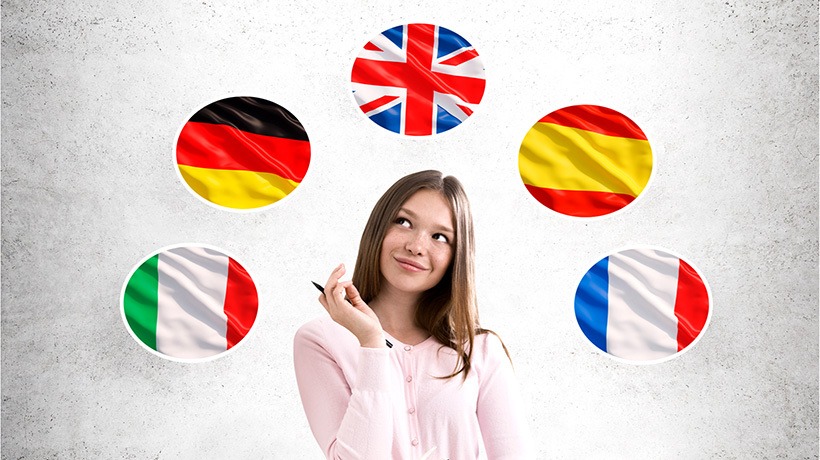Image Or Symbol: That Is The Question
All known language apps are designed with the assumption that images can be associated with the words in the target language. The designers of these apps believe that if a learner sees the image on the display and then a word in the target language he will be able, first, to recognize the meaning of a word and then remember it.
It is a misconception that impedes learning foreign languages. The possible origin of this misconception: we use images in children’s books because children are visual and images help them to establish an emotional connection to the situation drawn in pictures. The emotional connection is reinforced by adults reading the text aloud. After multiple readings of the pictorial text, children remember the text by heart and can reproduce the text looking at the pictures. Do pictures help one remember the text and recall it by heart? Of course, they are helpful since pictures act as anchors for the emotions that a child goes through when listening to the narrative.
How Do Children Think?
Here an important question arises: Do children think in images or in symbols? The word "symbol" is overused and has different meanings in various contexts. Generally, a symbol represents something other than itself. For example, the dove is a symbol of peace. We need a different definition of "symbol" as something that could be used for the representation of our thoughts before we acquire the language or before we verbalize our thoughts. Children think in "symbols" before they learn how to speak. A "symbol" for a child is not something fixed like a picture; it changes with time and serves as an association with a certain object, action, or feeling. Each time a child experiences a new modification of the object or slightly different feeling, it is infused into the same "symbol" that the child’s brain associates with a certain object, action, or feeling.
A symbol is the smallest element of the language of thoughts; it is an amalgamation of all images on the topic and all feelings experienced with this particular symbol. For example, the symbol "mommy" includes "averaged" or "fused" images of mother and feelings of love, warmth, security, known heartbeat, etc. Now, imagine that Mum wants to introduce a new symbol to her child: "calm" as a better alternative to "anger." She will demonstrate how it looks to be angry and how it looks to be calm. The expression on her face, her breathing, her movements, and her eyes—all these feelings matter in creating the two new symbols "anger" and "calm." Wiring of these symbols to the respective words—anger and calm—occurs after a child experiences these symbols multiple times together with the words describing them.
The Difference Between Images And Symbols
Children accumulate the database of symbols first and then they acquire the native language subconsciously by wiring the acquired symbols to the words directly and forming a speech center in the brain. There is a huge difference between an image and a "symbol." For example, the symbol of "breakfast" is a fusion of many meals in the morning that a child has experienced before he or she learned how to vocalize this symbol as the word "breakfast." An image (picture) of "breakfast" cannot be unambiguously connected to the word "breakfast" because each picture contains a multitude of keywords, for example, boy, girl, eating, cup, plate, milk, juice, table, etc. That explains why using images as anchors for learning new words in a foreign language is unproductive and brain-incompatible.
Adults think in symbols too that are already wired together with the respective words of the native language, thus creating the illusion that we think in the native language. You would realize that it is an illusion if you think about your dreams. Dreams are your subconscious thoughts. They are so bright, emotional, and clear, although they are created exclusively in the language of thoughts (symbols) and attempts to articulate them usually wake you up.
We may conclude that the objective of acquiring a foreign language for adults could be simplified as wiring the known symbols—and not images—with unknown words in a target language.
A Small Experiment
The following experiment is easy to perform. It will demonstrate the connection between the language of thoughts and the language of communication. Close your eyes and breathe deeply for a few minutes, paying attention to every inhale and exhale. Now, without opening your eyes and using the fingers of your hands count how many words you can recall in your native language. You will be surprised that for a few moments no words or very few words come to your mind. The explanation is simple: without any visual clues or thoughts you can’t recall words. Then, without opening your eyes, start thinking about this experiment and recall the words in your native language. Many words will appear in your mind as your thoughts activate the words needed for expressing your thoughts.
We can’t represent the known symbol as an image because each symbol is a representation of an object, action, or feeling and it is not fixed. A symbol contains the information elements that might change with experience. For example, think about a "driver." What appears in the mind as a symbol of a driver would be different for a poor child from a remote village in India and for a child from a metropolitan city. Remember that the symbol "driver" should appear in your mind before you can produce the word driver in your native or in a foreign language.
Technology And Learning A Foreign Language
The technology available today allows us to activate the symbol in our brain by demonstrating the word in the native language for a few seconds, and then demonstrating the respective word in a target language and asking the learner to pronounce it a few times simultaneously with a recording made by a native speaker.
Then this process is repeated but this time a whole sentence containing this symbol is displayed for about ten seconds in the native language. Never pronounce or read aloud the sentence in the native language. Then the same sentence is displayed in a target language and the learner repeats it aloud many times simultaneously with a recording.
Here is a description of this experiment with a concrete example.
First, display the word in the native language, for example, in Russian: Сад. After a few seconds, display the respective word in the target language, for example, in English: Garden.
Pronounce the word garden a few times simultaneously with the recording made by a native speaker. Now display in your native language (Russian) a sentence with the word "Сад" that will help you to visualize it and connect emotionally. Never pronounce it or read aloud. Я люблю гулять по цветущему саду.
Then display the same sentence in a target language (English) and repeat it aloud many times simultaneously with the recording. I like to walk in the flowering garden.
The transition to the new paradigm—words in the native language are wired together with the symbols in which we think—is not hard; we simply need to apply this truth to the acquisition of a foreign language and wire together the known symbols with unknown words in a target language.
Don’t use images for activating symbols in which we think. Remember, we think first before we can speak. Display a word in the native language for a few moments to activate the symbol and then visualize and verbalize it in a target language. First, apply it to a word, and then to a whole sentence. The entire process can be easily turned into an automatic subconscious training in foreign language skills.







